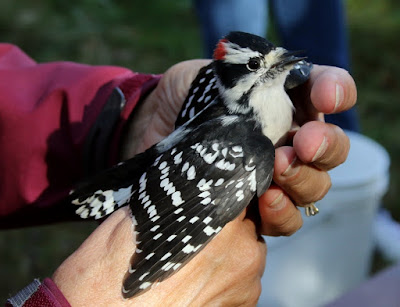By Beth Sullivan
The nets were raised
just after dawn. They were heavy with dew and needed to stretch and
dry. It was really quiet. The birds were totally silent in the
fields and thickets last Sunday when a small group of us gathered for
an annual ritual-Bird Banding at Avalonia’s Knox Preserve.
As the sky
brightened, we could sense a stirring. Some fluttering in the
bushes, the chip notes of Sparrows in the grasses , different chips
from Warblers , single notes from some, double notes from
Chickadees.
We have been doing
this for almost 30 years but the anticipation never changes; we are
always excited to think of what may be in store for us on this first
day of banding.
Morning catch
The nets are set up
along the trails of the preserve. The perfect site is one with
thicket rising on both sides of the trail. The dense vegetation is
where the birds hide, and rest and feed. The nets are dark filament,
and so fine, that they become almost invisible when one stares
through them into the bushes on the other side. That’s what
happens to the birds. They decide to fly from one side to the other,
do not see the net, and get lightly caught in the mesh. Each bird
species seems to react to this differently. The little Yellow Rumped
Warblers, which are the most abundant birds at this time of the year,
seem to just lay quietly; they don’t struggle and rarely get
terribly tangled. Chickadees, on the other hand, are little dynamos.
They fuss and fidget and grab the net with their feet. When we start
to remove them, they peck mercilessly on our fingers.
Our first trip
around the circuit always seems to produce the most birds. They are
intent on finding food in the morning after a long cool night. A
flock of about a dozen Yellow Rumped Warblers, flying generally
together, all landed in the first set of nets. It was a promising
start. There were several Chickadees requiring patience and gentle
fingers, a Song Sparrow and, the big catch - a Blue Jay. When these
big fellows hit the net, they often bounce right out. You have to get
to it quickly and prevent escape if you want it on your list for the
day.
Each bird is placed
in a cotton bag or in compartment in a special box for transport
back to our station set up with supplies.
 |
| Birds are trapped by fine mist nets. |
 |
| Chickadees stay busy pecking through the whole process. |
 |
| Removal from the net requires very patient fingers. |
The actual process
of banding itself is simple - the placement of an aluminum band on
the bird’s leg, that will remain with it for life. It does not
hurt; it will not impede, and it is like having a social security
number on a bracelet. The bird is identified for life with a unique
series of numbers. If it is caught again, or found dead, that
number can be traced to the very place and date when it was first
banded.
While we have the
bird in our hands though, there is so much else to learn. We can
determine a lot by looking at the plumage. Some young birds have
different markings or coloration than older, adult birds. On the
warblers, we look at the brightness of yellow patches and intensity
of the markings. We also count the spots on the tail feathers.
Sometimes eye color
is important. An adult Downy Woodpecker will have red eyes. We also
measure wing length as it can sometimes tell us gender, but not
always. To determine age, a small drop of plain water is used to
spread the feathers on the bird's head to determine the amount of
solid bone present. Like a newborn human, the young birds have a
soft spot, a place where the bone in the skull is not closed yet, and
it shows as a pink patch of skin, not white bone. We also weigh the
birds. The weight is quite variable depending on recent food intake,
or recent excretion. But it is all important data. It is a lot to
keep in one’s head, but we have books with charts and guidance, and
lots of practice.
Tally for the day
At the end of the
day we had caught and banded 13 Yellow Rumped Warblers, 7 Chickadees,
2 Blue Jays, 1 Song Sparrow and a Downy Woodpecker. We did have a
few escapees.
We also caught a
Chickadee that already had a band on it. By looking back into the
record book, we found that we banded that little bird on Oct 22,
2014. It was also caught again on November 4, 2015. To be recaptured
on Sunday Oct. 22 2017 was quite a record!
For me, sharing the wonder of birds with others, especially children,
is as much fun as handling the birds myself. To let a child hold a
bird for the first time, to feel its light warmth and energy, to
look in its eyes and make contact. It is something that child will
hold onto forever.
 |
| The Blue Jay is the catch of the day. |
 |
| This young male Downy Woodpecker shows off his colors. |
 |
| To be able to hold a small wild birds is something she will likely remember for a long time. |
Photographs by Rick
Newton.

No comments:
Post a Comment